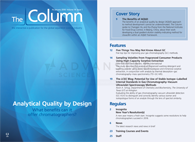Five Things You May Not Know About GC
Five top tips for improving your gas chromatography (GC) methods.
Photo Credit: Es sarawuth/Shutterstock.com

Five top tips for improving your gas chromatography (GC) methods.
These five tips for gas chromatography (GC) could improve your methods.
Hydrogen Is the Best Carrier Gas
Hydrogen can provide increased analysis speed by increasing carrier gas linear velocity without losing too much efficiency, allowing for shorter run times and thereby increasing throughput. Lower temperature separations are another benefit; at faster elution times, it may not be necessary to increase the column temperature ramp rate. It may even be possible to lower the maximum temperature needed for the analysis, which will reduce the reequilibration time too. The use of lower temperatures leads to less column bleed, which in turn can mean a longer column life. Hydrogen is readily available through the electrolysis of water and, with gas generators, it can be generated safely on demand. Hydrogen gas is already used in the laboratory for a variety of purposes; it is the fuel gas for the most commonly used GC detector, the flame ionization detector.
GC–MS Columns for GC Methods
Analytical sensitivity and detection limits are ultimately a function of the signal-to-noise ratio (S/N). A decrease in noise increases sensitivity. All GC columns bleed, although polar phases and thicker films are more prone to bleed. This normal degradation of the stationary phase polymer results in increased baseline noise. Degradation is accelerated when excess oxygen is present and at higher temperatures; hence the elevated baseline that is seen as the temperature rises to the column’s upper limit. Columns designated for gas chromatography–mass spectrometry (GC–MS) have been designed to exhibit reduced bleed and high inertness at elevated temperatures, which ultimately increases S/N. Many detectors are sensitive to contamination from bleed products and require less maintenance when using lowâbleed columns. For GC–MS applications, low-bleed stationary phases reduce column contribution to background noise, resulting in improved mass spectral purity and moreâaccurate library identification.
Advantages of Highly Inert Columns
Manufacturers have developed new ways of deactivating GC columns in recent years, which provides improved sensitivity because they exhibit low bleed and low silanol activity. Decreased silanol activity is particularly pertinent when analyzing bases or polar compounds, or for certain specialist applications, such as pesticide, food, environmental, or drug analyses, all of which require ever decreasing detection limits. Active silanol species in the column can interact with bases or polar compounds and cause peak tailing that impacts sensitivity (via reduced peak heights relative to baseline noise) and makes integration (and hence quantitation) more challenging and less reproducible. The benefit of highly deactivated columns can only be fully realized in conjunction with a system that has an inert flow path (that is, inlet liner and packing, column, ion source, and so forth). Any advantages from low silanol activity in only the column will be mitigated if peak tailing occurs in the inlet. Most manufacturers provide highly inert consumables, including liners and packing, as well as deactivated inlets.
A Little Bit of Split
Splitless injection is used for lowâconcentration samples to provide optimum sensitivity. Sample vapour transfer from the inlet is much slower compared with split injection, resulting in band broadening; therefore, sample vapours must be trapped at the head of the column by using a low initial oven temperature. If some sensitivity can be sacrificed, it may be better to use a little bit of split, for the following reasons:
- Better peak shape: the liner is cleared more quickly, which introduces the analytes onto the column in a narrower band.
- No need for cryo-cooling: the analytes are being introduced in a narrower band; hence, the oven temperature does not need to be lowered to allow for focusing at the head of the column.
- Shorter run times: analyses can be started at higher initial oven temperatures, which decreases run and oven reequilibration times.
- Use of isothermal methods: with no need for low initial oven temperatures, isothermal methods that start at higher temperatures can be used. These methods are particularly good for samples that contain higher boiling point components.
A split of 1:10 is good for balancing sensitivity with the benefits of split injection.
The Wonder of Gas-Saver Mode
Gas-saver mode can be used during split injection to change the split ratio at a specified time after sample injection, which reduces carrier gas consumption. For example, if the split flow rate is reduced from 150 mL/min to 25 mL/min 1 min after sample injection (ensure all the sample and solvent vapours have been transferred to column prior to using the gas saver), the reduced split flow rate can be maintained throughout the analytical run until the next analysis. Under these conditions, that is a 79% gas saving per analysis: analysis time: 20 min; split ratio: 100:1; gas saver mode: split ratio 15 after 1 min; column temperature: 100 °C; column: 30 m × 0.25 mm, 0.25-µm.
Find this and more at www.CHROMacademy.com/Essentials

Detecting Hyper-Fast Chromatographic Peaks Using Ion Mobility Spectrometry
May 6th 2025Ion mobility spectrometers can detect trace compounds quickly, though they can face various issues with detecting certain peaks. University of Hannover scientists created a new system for resolving hyper-fast gas chromatography (GC) peaks.
Altering Capillary Gas Chromatography Systems Using Silicon Pneumatic Microvalves
May 5th 2025Many multi-column gas chromatography systems use two-position multi-port switching valves, which can suffer from delays in valve switching. Shimadzu researchers aimed to create a new sampling and switching module for these systems.
New Study Reviews Chromatography Methods for Flavonoid Analysis
April 21st 2025Flavonoids are widely used metabolites that carry out various functions in different industries, such as food and cosmetics. Detecting, separating, and quantifying them in fruit species can be a complicated process.

.png&w=3840&q=75)

.png&w=3840&q=75)



.png&w=3840&q=75)



.png&w=3840&q=75)












